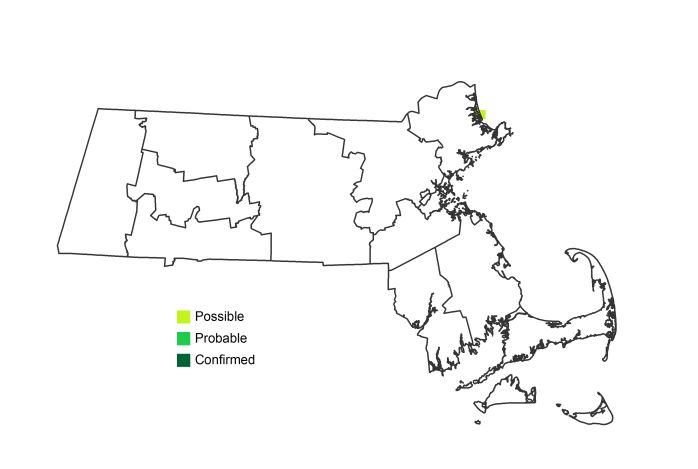Breeding Bird Atlases (BBA)
Find a Bird
Ruddy Duck
Oxyura jamaicensis

Very local, trend not established
“When the dog approached I observed that the Duck had seized his nose with its bill; and when I laid hold of it, it tried to bite me also. I have found this species hard to kill, and when wounded very tenacious of life, swimming and diving at times to the last gasp.” – John James Audubon, Birds of America
Though it is one of our most diminutive waterfowl, few species cut a more impressive figure in courtship than a male Ruddy Duck. With his bright blue bill waving up and down and his stiff, spiny, black tail held aloft, his spectacle is a pleasure to watch. Though this species is known best to Massachusetts birders as a fall migrant, Ruddy Ducks nonetheless have a fairly long history of breeding in Massachusetts. It was probably never a common breeder in the Bay State, which sits at the easternmost edge of its American breeding range, and its future appears more uncertain than its past.
Historic Status
Things seemed to be going well for the Ruddy Duck in the nineteenth century until the Canvasback began its decline on the eastern seaboard in the face of hunting pressure. At that same time, the Ruddy Duck found itself also targeted, being sold as early as the 1840s in Boston markets as “Dun-birds” or “squab Canvasback.” An increase in the harvest of Ruddy Ducks in the south in the late 1800s led to a reduction of the population in the Northeast by the time Edward Howe Forbush boldly stated in 1912, “The Ruddy Duck breeds normally in Massachusetts,” citing examples on Cape Cod, Cohasset, Wakefield, and elsewhere. The same author, writing just eighteen years later, listed Ruddy Ducks as “rare, irregular and apparently diminishing,” and “so rare as to be unimportant in New England” (Forbush 1925). Legal protection gained under the Migratory Bird Treaty Act allowed the species to rebound, and in the 1950s construction of the impoundments at the Parker River National Wildlife Refuge offered safe prospective new breeding habitat.
Atlas 1 Distribution
Ruddy Ducks maintained their status as occasional breeders in small numbers during Atlas 1. Though volunteers scoured the Bay State in search of these diminutive stiff-tailed waterfowl, they were not discovered at most of the sites where the ducks were historically known to breed, such as Pilgrim Lake at North Truro or in West Newbury. The one place that they did turn up was Parker River National Wildlife Refuge, that Essex County haven for so many rare and unusual breeding waterfowl. The 2 occupied blocks in the northern Coastal Plains constituted the entirety of known Ruddy Duck breeding activity in Atlas 1.
Atlas 2 Distribution and Change
The demise of the Ruddy Duck as a breeding bird in Massachusetts may have reached its conclusion since the species was not Confirmed breeding in the state during Atlas 2, and was recorded from only a single block in Essex County. Given the past history and irregular nesting of the species in the Commonwealth in the past, it may not be unreasonable to expect nesting again in the future, but it is, at best, a boutique species in the Bay State.
Atlas 1 Map

Atlas 2 Map

Atlas Change Map

Ecoregion Data
Atlas 1 | Atlas 2 | Change | ||||||
Ecoregion | # Blocks | % Blocks | % of Range | # Blocks | % Blocks | % of Range | Change in # Blocks | Change in % Blocks |
Taconic Mountains | 0 | 0.0 | 0.0 | 0 | 0.0 | 0.0 | 0 | 0.0 |
Marble Valleys/Housatonic Valley | 0 | 0.0 | 0.0 | 0 | 0.0 | 0.0 | 0 | 0.0 |
Berkshire Highlands | 0 | 0.0 | 0.0 | 0 | 0.0 | 0.0 | 0 | 0.0 |
Lower Berkshire Hills | 0 | 0.0 | 0.0 | 0 | 0.0 | 0.0 | 0 | 0.0 |
Vermont Piedmont | 0 | 0.0 | 0.0 | 0 | 0.0 | 0.0 | 0 | 0.0 |
Berkshire Transition | 0 | 0.0 | 0.0 | 0 | 0.0 | 0.0 | 0 | 0.0 |
Connecticut River Valley | 0 | 0.0 | 0.0 | 0 | 0.0 | 0.0 | 0 | 0.0 |
Worcester Plateau | 0 | 0.0 | 0.0 | 0 | 0.0 | 0.0 | 0 | 0.0 |
Lower Worcester Plateau | 0 | 0.0 | 0.0 | 0 | 0.0 | 0.0 | 0 | 0.0 |
S. New England Coastal Plains and Hills | 2 | 0.7 | 100.0 | 1 | 0.4 | 100.0 | -1 | -0.4 |
Boston Basin | 0 | 0.0 | 0.0 | 0 | 0.0 | 0.0 | 0 | 0.0 |
Bristol and Narragansett Lowlands | 0 | 0.0 | 0.0 | 0 | 0.0 | 0.0 | 0 | 0.0 |
Cape Cod and Islands | 0 | 0.0 | 0.0 | 0 | 0.0 | 0.0 | 0 | 0.0 |
Statewide Total | 2 | 0.2 | 100.0 | 1 | 0.1 | 100.0 | -1 | -0.1 |



